Apr 25, 2019

Your car brakes are vital for the safety of your passengers, other road users and of course, yourself. Legally they must be kept in good working order as your brakes will be tested at your annual MoT test and when you have your car serviced. If you think there is a problem with your car brakes, there are a number of different parts that might need to be replaced or repaired.
Here, we have provided an easy-to-understand guide explaining how each brake part works and how to find out when they need to be repaired.
Most cars have disc braking systems so we’ll be covering what parts are required for a disc brake.
When your car has disc brakes, the wheels are attached to metal brake discs. These brake discs spin at the same speed as the wheels. A brake caliper sits around the discs, a bit like a clamp. When you press on the brake pedal, brake fluid creates hydraulic pressure on the pistons in the caliper causing it to grip the disc which slows the disc and the wheels down.
The brake calipers have two metal parts covered with high friction material - these are the brake pads which squeeze the disc to slow it down.
The main parts that make up your car brakes are; brake discs, brake calipers and brake pads. Brake pads and discs are the parts most likely to suffer wear and tear and will need to be replaced regularly.
How often will brake pads and brake discs need to be replaced?
How often you replace your brake pads and discs will depend on your driving style, if you frequently brake sharply the quicker your pads and discs will wear out. The more miles you cover, the more often you will have to consider brake pad or brake disc replacement. The average can be between 25,000 to 65,000 miles which is a fairly wide range.
The final contributing factor to the frequency of brake pad replacement is the type of brake pads you choose. There are 3 main types of brake pads; these are organic, metallic and ceramic. Your mechanic will advise on the best type of brake pads for your car.
The main pros and cons of each type of brake pad:
How do you know when your brake pads need to be replaced?
If your pads are very worn you may have squeaky breaks or hear a screeching grinding noise as you come to a stop. This happens as the metal of the brake pad meets the metal of the disc.
A mechanic will know as soon as they look at the pads if they need to be changed by the thickness of the friction material. Your garage will measure the thickness with a gauge, if it is 4mm or less then it should be replaced.
If you see a dashboard warning light for low brake fluid it may also indicate that your pads are worn. More brake fluid is used when the pads are worn. So from time to time, you will have to have brake fluid change.
You can get repair costs for brakes online by entering your registration on MyCarNeedsA.com and we’ll email quotes from trusted garages near you. All you have to do is choose the one that suits you best.